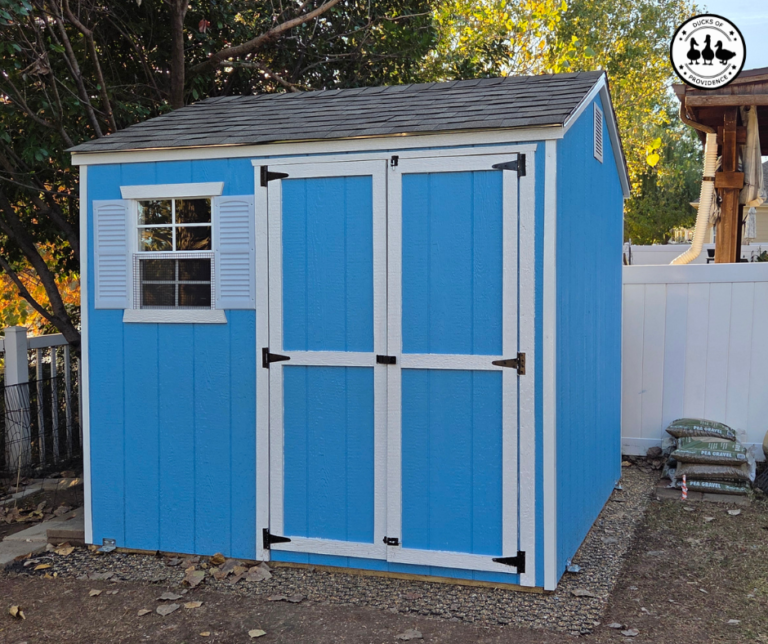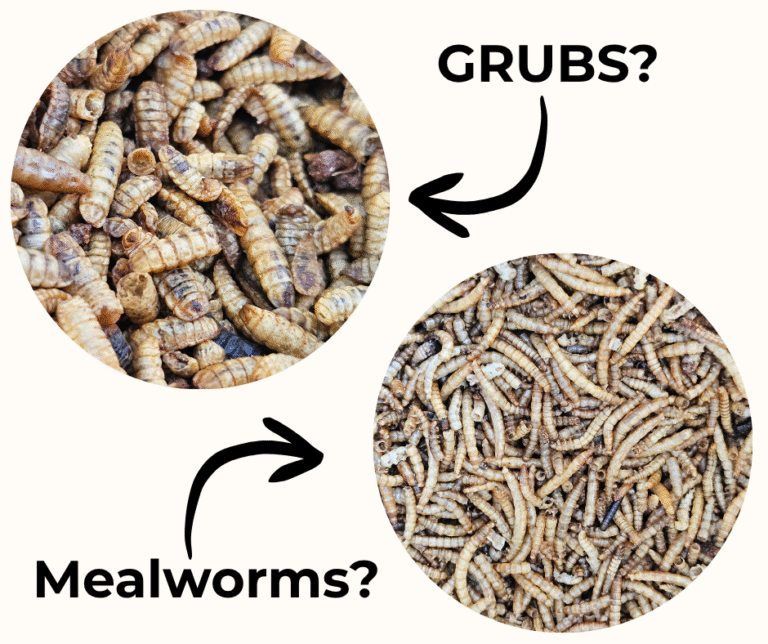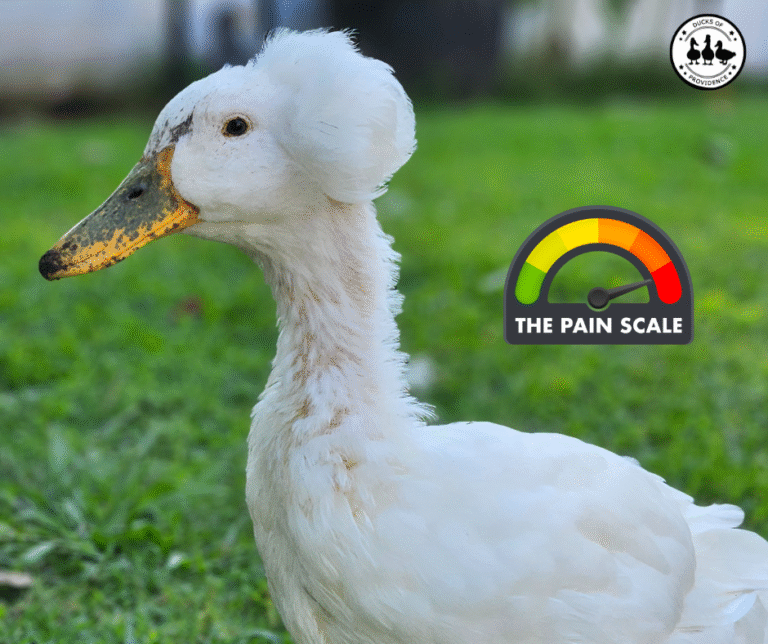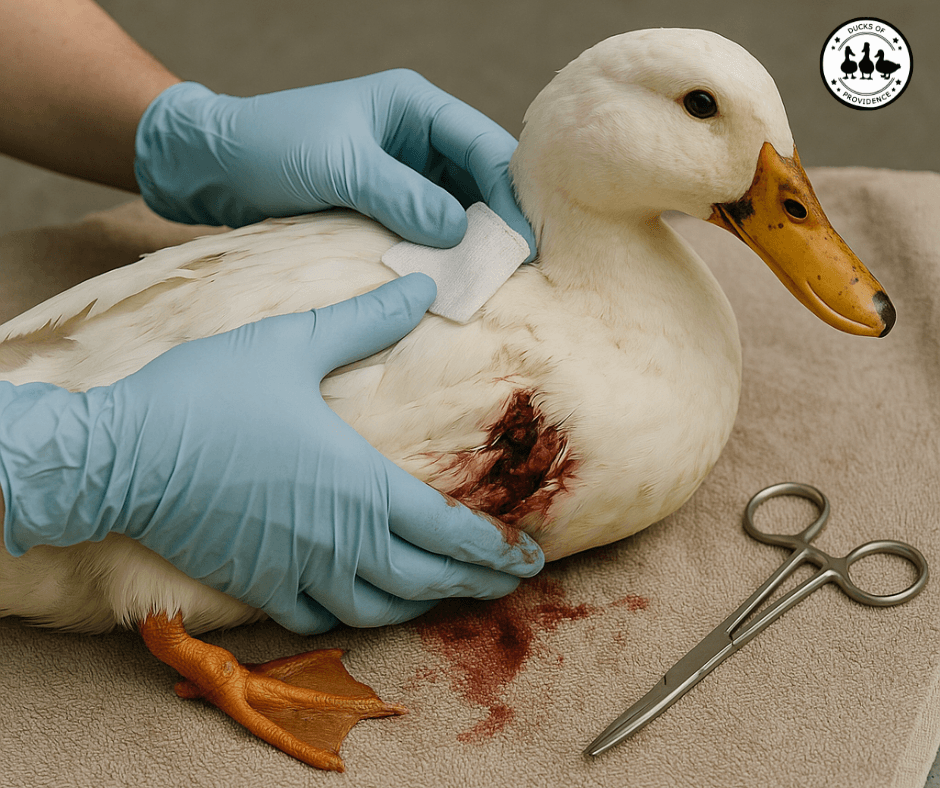
Emergency Care for Ducks After a Predator Attack: First Aid, Treatment, and When to See a Vet
Last updated on July 5th, 2025 at 03:10 pm
A predator attack is one of the most terrifying experiences for any duck keeper. Whether it happens in the middle of the night or during the day, the aftermath can leave you overwhelmed and unsure of what to do next. In this guide, we’ll walk you through duck predator attack emergency care—from assessing injuries and administering first aid to knowing when veterinary help is needed.
We’ll also talk about how to prevent future attacks by predator-proofing your duck coop and run, and we’ll share the supplies every duck parent should have on hand for moments like these. Whether you’re responding to an active emergency or preparing ahead of time, this post is here to help you feel more confident and ready to care for your flock.
Ducks of Providence is free, thanks to reader support! Ads and affiliate links help us cover costs—if you shop through our links, we may earn a small commission at no extra cost to you. Thanks for helping keep our content free and our ducks happy! 🦆 Learn more
The Role of Prevention: Why Predator-Proofing Matters
Predators are one of the biggest threats to backyard ducks, especially at night when As duck keepers, we spend countless hours providing enrichment, feeding the right diet, and making sure our ducks are healthy and happy. But none of that matters if we don’t protect them from one of the biggest threats they face: predators.
Unfortunately, ducks are incredibly vulnerable animals. They don’t fly away like wild birds, they don’t have sharp claws or teeth to defend themselves, and many domestic breeds can’t even move quickly enough to escape an attacker. Most will freeze or panic if cornered—and that can make even a determined housecat a serious threat.
Most Attacks Happen at Night—But Not All
Many predators, such as raccoons, foxes, coyotes, and owls, are nocturnal and strike when your flock is sleeping. That’s why having a secure night-time coop is absolutely essential. But attacks can also happen in broad daylight—hawks, neighborhood dogs, and even human intruders can cause harm during the day. A secure daytime run is just as important.
What Makes a Coop or Run Truly Predator-Proof?
Predators are smart and persistent. A coop that looks sturdy might still have weak points. Here are a few prevention tips we swear by:
- Use hardware cloth, not chicken wire. Chicken wire keeps ducks in but doesn’t keep predators out. Raccoons and even rats can chew or squeeze through.
- Bury the fencing. Predators like foxes and raccoons will dig. Bury your hardware cloth at least 12 inches underground, or flare it outward at a 90° angle along the perimeter.
- Lock all latches. Sliding latches can be opened by raccoons. Use padlocks or carabiners—especially on nesting box doors and access hatches.
- Cover the run completely. Hawks and owls are silent and deadly. Don’t just use netting; cover the run with hardware cloth or solid roofing. This also protects against droppings from wild birds during disease outbreaks like avian influenza.
- Check for gaps regularly. Wood warps, soil settles, and small tears in mesh can grow. Do a perimeter check at least once a month, and especially after storms or freezes.
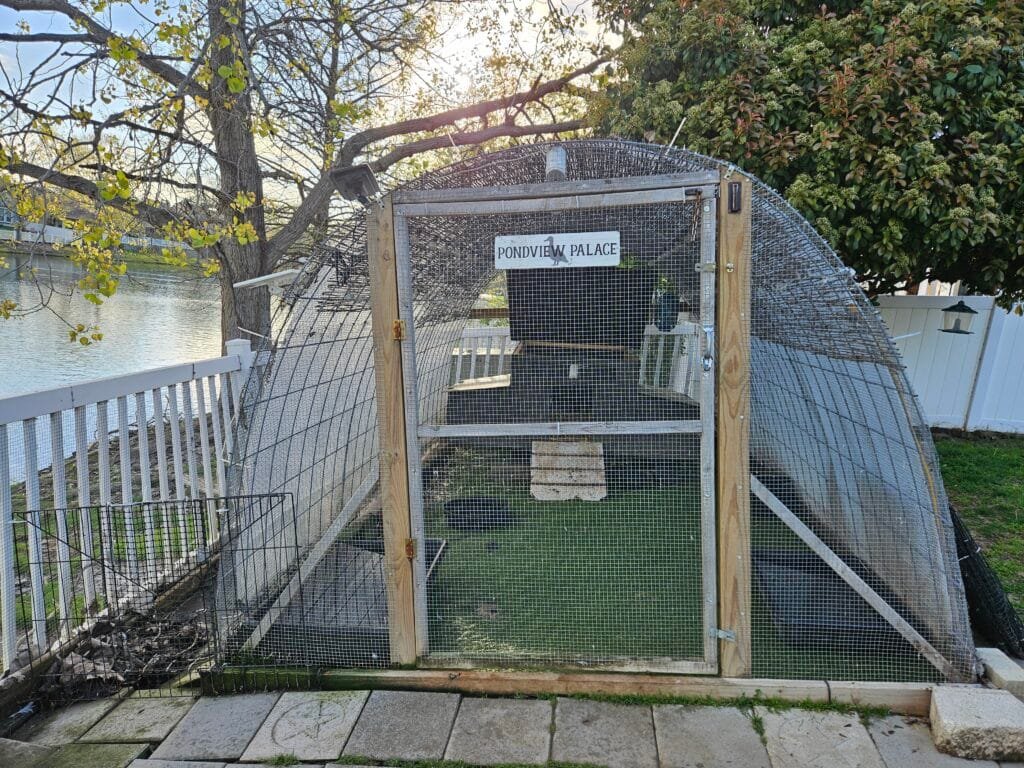
Flock Safety Is an Ongoing Job
Even if you’ve never had a predator issue, it doesn’t mean you’re in the clear. Predators are opportunistic. They may not show interest until they’re hungry—or until the weather changes and they become more desperate. Prevention means staying one step ahead, always checking for weaknesses, and adapting your setup as needed.
Want to Learn More?
We’ve put together a more comprehensive guide on the most common and not-so-common predators, how they attack, the signs they leave behind, and how to protect your flock from each one.
➡️ Read next: Common and Uncommon Duck Predators—and How to Keep Your Flock Safe
First Steps After an Attack
A predator attack is one of the most stressful moments any duck parent can face. In the chaos, it’s easy to panic—but taking calm, deliberate steps can make a real difference in your ducks’ recovery and safety. Here’s what you should do immediately following an attack:
1. Make Sure the Predator Is Gone
Before rushing in, ensure that the threat has truly passed. If you interrupted the attack or arrived moments after, the predator may still be nearby—especially if it’s a dog, raccoon, or owl. Always prioritize your own safety first. If the animal is still present and dangerous, contact animal control or your local wildlife agency for help. Once the area is secure, you can safely assess the damage.
2. Remove All Ducks from the Area
Quickly but gently gather your ducks and move them into a secure, enclosed space—ideally indoors or into a safe secondary coop or predator-proof run. This serves two purposes: it protects them from another possible strike and removes them from the traumatic environment where the attack occurred. Try to keep your voice calm and your movements slow. Your ducks will be scared and disoriented, and your reassurance can help settle them.
3. Do a Headcount
Even if the run appears empty, one or more ducks may have fled in panic and are now hiding in bushes, under decking, or in other hard-to-see areas. Count your ducks and keep looking until every member of your flock is accounted for. Injured ducks may be hiding silently, and shock can cause them to remain completely still even if you’re calling them. Use a flashlight if it’s dark and check all corners thoroughly.
4. Separate Injured Ducks
Once you’ve gathered the flock, check for visible signs of injury. Any duck showing wounds, limping, struggling to stand, or acting lethargic should be separated immediately. Even in peaceful flocks, other ducks may peck at injuries, which can quickly worsen the situation. Place the injured duck in a warm, quiet, and dimly lit area where they can rest without added stress.
5. Handle Your Ducks Gently
Even if a duck appears unhurt, it may still be in shock, which can be just as dangerous as a physical injury. Signs of shock include a limp body, closed or half-closed eyes, shallow breathing, and cold feet or bill. Handle your ducks with care—wrap them in a soft towel if needed, avoid loud noises, and don’t crowd them. Keeping them calm and warm is the most important thing in these first few minutes.

Common Injuries and How to Treat Them
Every predator attacks differently, and the type of injuries your duck might suffer often depends on who the attacker was. Raccoons tend to go for the head and neck, dogs can crush or maul, and birds of prey might puncture or slash with talons. Regardless of the wound, prompt and appropriate care is essential—not only to stabilize your duck but also to prevent infection, which is a major risk, especially from bite wounds.
Predator saliva contains harmful bacteria, and even a small puncture can quickly become infected or lead to systemic illness if not properly treated. In some cases, infection from a bite can be more dangerous than the injury itself. That’s why cleaning, disinfecting, and monitoring wounds carefully over the following days is so important.
Here are the most common types of injuries we see after predator attacks, and how to treat them:
🩸 Puncture Wounds (Common with Bites and Talons)
Signs: Small holes in the skin, often hidden under feathers. May bleed minimally but can be very deep. Look carefully around the neck, back, and thighs—areas most targeted in attacks.
Treatment:
- Trim feathers around the wound to expose the area.
- Flush thoroughly with sterile saline or diluted Betadine solution (about 1:10 with water).
- Apply a triple antibiotic ointment (without painkillers like lidocaine or benzocaine). Alternatively, you can apply Vetericyn wound spray, Vetericyn Wound Care Hydrogel, PetSilver wound Spray, or Manuka Honey. It depends on the severity of the wound and what you may have on hand.
- Monitor closely—bite wounds carry high risk of infection due to bacteria from the predator’s mouth.
- Keep the duck dry, warm, and isolated from other birds while healing.
- If swelling, discharge, foul smell, or heat develops—this is a sign of infection, and your duck needs veterinary antibiotics.
⚠️ Never Use Blue Kote on Ducks
Warning: Do not use Blue Kote or similar gentian violet-based sprays on ducks. While commonly used in poultry and livestock, Blue Kote is toxic to waterfowl. Ducks preen their feathers constantly, and ingesting even small amounts of this product can lead to serious health issues, including neurological symptoms, poisoning, or death.
🛑 How to Stop Bleeding: Styptic Powder and Cornstarch
Some injuries may bleed more than others—especially wounds on the feet, bills, or near blood feathers (those growing in during molt). While minor bleeding often stops on its own, ducks can lose a dangerous amount of blood quickly if a major vessel is damaged or if they continue to move around.
Stopping the bleeding quickly is not just about keeping things tidy—it’s about preventing shock, blood loss, and further injury.
✨ Styptic Powder
Styptic powder is a must-have in your duck first aid kit. It’s specially formulated to help blood clot quickly.
How to use it:
- Apply firm pressure to the wound with a clean gauze or towel for about 1–2 minutes.
- Once the bleeding slows, dip a cotton swab into the styptic powder or use a pinch with your fingers.
- Apply directly to the bleeding site. Don’t rub—just press gently for 10–15 seconds.
- Hold your duck still and calm for a few minutes to allow clotting to complete.

💡 Note: Styptic powder can sting slightly. Avoid using it on large open wounds or near the eyes, vent, or mucous membranes.
🌽 Cornstarch or Flour (In a Pinch)
If you don’t have styptic powder on hand, plain cornstarch or all-purpose flour can also help stop minor bleeding. While not as fast-acting as styptic powder, they’re safe, gentle, and effective for smaller cuts or broken blood feathers.
How to use cornstarch or flour:
- Pat the area dry if needed.
- Sprinkle the cornstarch or flour generously over the bleeding spot.
- Apply light pressure with a clean cloth until the bleeding stops.
These are excellent to keep in your emergency kit as a backup—even if you already have styptic powder on hand.
🩹 Surface Cuts and Scrapes
Signs: Visible scratches, abrasions, or shallow lacerations, often from claws, beaks, or getting caught while escaping.
Treatment:
- Clean the area with saline or antiseptic rinse.
- Apply an antibiotic ointment and cover lightly if possible (especially on areas prone to dirt or pecking).
- Change bandages daily and continue treatment until the wound closes and scabs over.

🪶 Feather Loss and Skin Tears
Signs: Large bald patches, sometimes with missing skin or exposed tissue. Can occur from grabbing, tearing, or rough landings while fleeing.
Treatment:
- Gently clean the area with warm water or antiseptic rinse.
- If skin is torn but intact, apply antibiotic ointment and consider light bandaging.
- Deep tears (especially if skin flaps or muscle is exposed) should be assessed and likely sutured by a vet.
- Keep flies away from open wounds to prevent flystrike—a life-threatening condition.
🦴 Broken Wings or Legs
Signs: Dragging a limb, not putting weight on a foot, or holding a wing in an unnatural position. Sometimes there’s swelling or audible cracking.
Treatment:
- Gently restrain the duck to avoid further injury.
- Wrap the injured limb to stabilize it using gauze and vet wrap—but don’t wrap too tightly.
- Do not attempt to realign bones yourself. A vet is essential here.
- Pain management and possibly surgery may be needed.
❄️ Shock
Signs: Weakness, closed eyes, rapid or shallow breathing, limpness, cold feet or bill. Shock can occur even in uninjured ducks due to fear or blood loss.
Treatment:
- Move the duck to a quiet, warm, and dimly lit space.
- Wrap gently in a towel or blanket.
- Offer fluids with electrolytes (like Save-a-Chick) using a syringe or small bowl.
- Allow the duck to rest undisturbed. Monitor closely for signs of improvement.
🏥 Set Up a Sick Bay
After triage and first aid, injured ducks need a clean, stress-free place to recover. We call this our duck sick bay. It doesn’t have to be fancy—just safe, warm, and separate from the main flock.
One of the easiest solutions? A large pet playpen or portable puppy enclosure.
Here’s how to create an effective sick bay:
- Use a foldable, soft-sided or wire playpen lined with puppy pads or clean towels.
- Add a low water dish and a small food bowl—make sure they’re easy to access.
- Keep it in a quiet room indoors or a protected outbuilding (garage, shed) where predators can’t reach and temperature can be controlled.
- Use heating pads or ceramic heaters if needed—especially for ducks in shock or with exposed skin.
- Clean the area daily and monitor wounds at least twice a day.
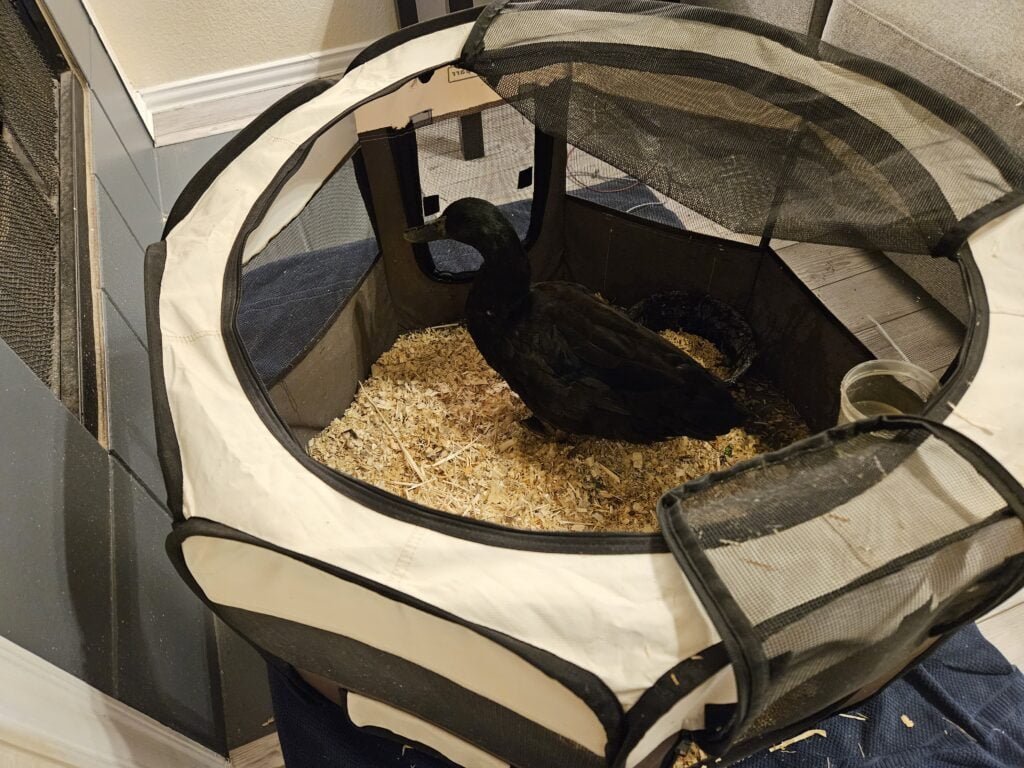
This setup not only makes wound care easier but also helps reduce the risk of further stress and injury from other flock members. Even the sweetest flockmates may peck at a wound out of curiosity or dominance.
Your Emergency Duck First Aid Kit
When something goes wrong, time matters. Having a well-stocked first aid kit ready to go can make all the difference in how quickly and effectively you can respond to a predator attack or injury. Even just having the basics on hand can help stabilize your duck until you can get to the vet—or, in some cases, prevent the need for a vet visit at all.
We keep our emergency supplies in a large plastic toolbox that’s easy to grab and carry outside. You can use any clean, sealable container, but make sure it’s clearly labeled, organized, and stored somewhere cool and dry.
Here’s what we recommend having in your duck first aid kit:
🧴 Wound Care Essentials
These help you clean, disinfect, and treat cuts, scrapes, and punctures.
- Sterile saline rinse or wound wash – For flushing debris and cleaning wounds gently.
- Diluted Betadine or chlorhexidine solution – Broad-spectrum antiseptics that help disinfect without damaging tissue.
- Triple antibiotic ointment (no pain relievers) – For topical use on wounds to prevent infection. Brands like Neosporin without painkillers are safe.
- Cotton pads or gauze – For cleaning, applying ointment, or cushioning injuries.
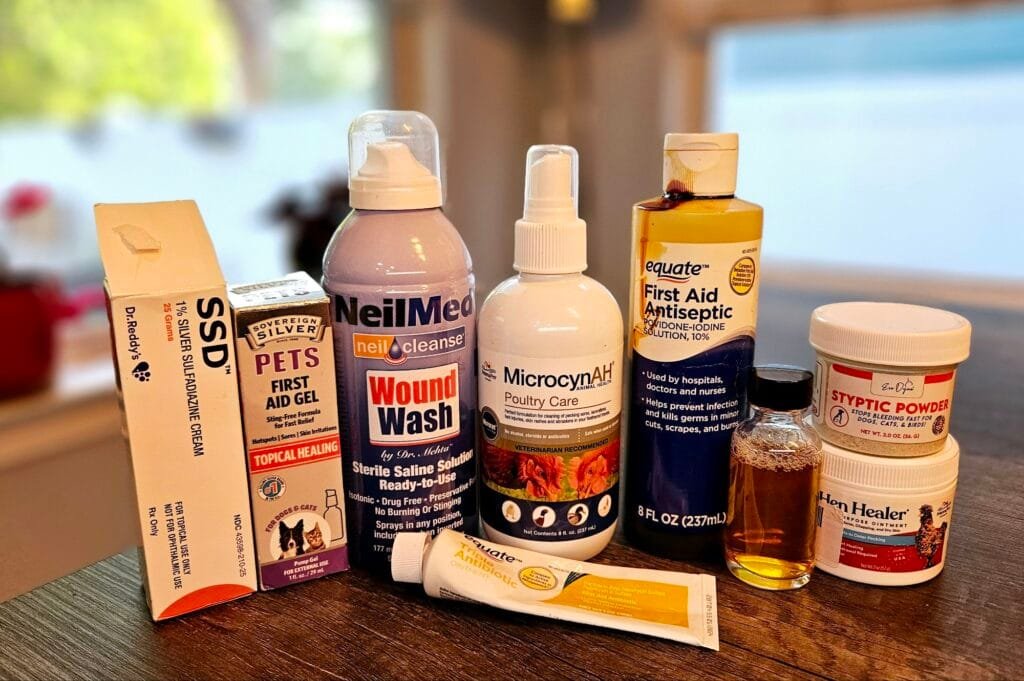
⛑️ Bleeding Control
Quick action here is critical for preventing shock and blood loss.
- Styptic powder – Instantly clots bleeding from small wounds or broken blood feathers.
- Cornstarch or flour – A natural alternative to stop minor bleeding if you don’t have styptic powder on hand.
- Clean cloths or rags – For applying pressure or wrapping bleeding limbs.
🩹 Bandaging Supplies
Used to stabilize limbs, cover wounds, and protect healing injuries.
- Vet wrap – Flexible, self-adhering wrap that won’t stick to feathers or skin.
- Rolled gauze and non-stick pads – For layering under vet wrap or cushioning more severe wounds.
- Medical tape and blunt scissors – To cut and secure bandages safely.
🥤 Hydration and Nutrition Support
Essential for ducks in shock, stressed birds, or those refusing to eat.
- Electrolytes (like Save-a-Chick, Hydro-Hen, or Nutri Drench) – Mix with water to help restore hydration and support recovery.
- Syringes or droppers (without needles) – To administer fluids or soft foods to ducks too weak to drink or eat.
- Baby food (plain squash, peas, or sweet potato) – A gentle, easy-to-digest option for syringe feeding if needed.
- Activated charcoal powder (optional) – May be used for toxin ingestion under vet guidance.

🦆 Monitoring Tools
To keep track of your duck’s condition and support safe healing.
- Digital thermometer – For checking ambient temperature in the sick bay or your duck’s body temp (via the vent, if you’re trained).
- Disposable gloves – To prevent contamination when treating wounds.
- Tweezers or forceps – For removing debris or inspecting wounds.
- Flashlight or headlamp – For better visibility during night-time emergencies.
🏥 Housing and Recovery Setup
Your kit should work hand-in-hand with a temporary sick bay setup.
- Puppy playpen or portable crate – A perfect low-cost solution to isolate an injured duck indoors or in a safe outbuilding.
- Puppy pads or clean towels – Line the playpen for easy cleanup.
- Heating pad or ceramic heat emitter (with thermostat) – Essential for shock recovery and for keeping injured ducks warm.
📋 Records and References
Helpful for staying organized during stressful times.
- Notebook or duck health binder – Track symptoms, treatments, and vet notes.
- List of local vets and emergency clinics – Include phone numbers, addresses, hours, and notes about duck experience.
- Printouts of duck-safe medication dosages – From trusted sources like DuckDVM or your own vet.
- Photos of each duck – Useful if you ever need to describe or identify an individual quickly in an emergency.
🪶 Optional But Helpful Additions
- Collapsible pet carrier – For quick transport to the vet.
- Thermometer strips for the sick bay – Easy way to monitor temperature in your duck’s recovery area.
- Feather trimmers (blunt-end scissors) – To expose wounds safely during treatment.
🛒 Looking for the Right Supplies?
To make things easier for fellow duck parents, we’ve curated a list of our favorite and most reliable first aid essentials on Amazon—the same products we use in our own kit here at Ducks of Providence. From vet wrap to electrolyte packs and safe wound care solutions, everything is organized and easy to shop.
➡️ Click here to view our Emergency Duck First Aid Kit list on Amazon
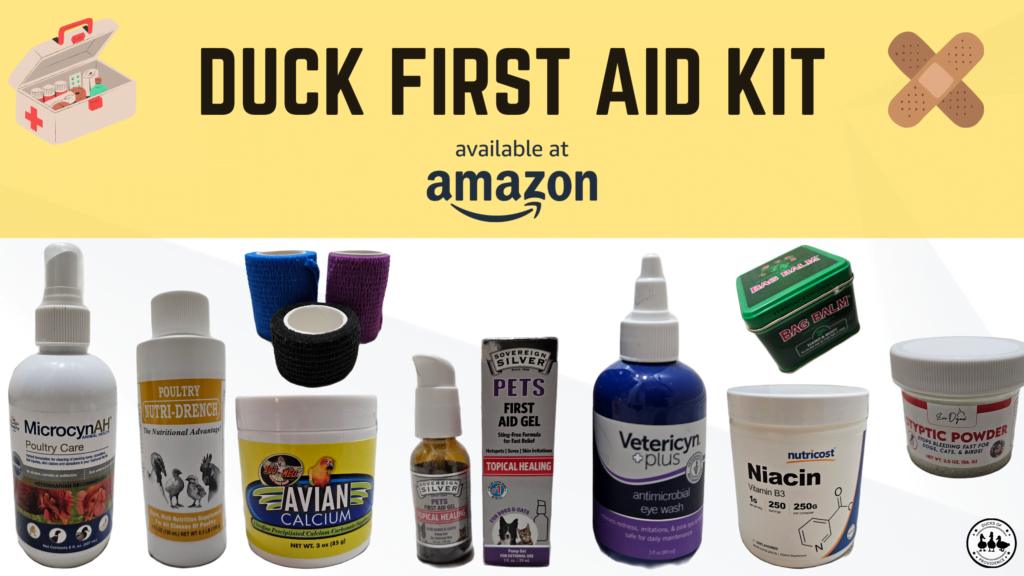
We’ve also written a detailed guide entirely focused on assembling your duck first aid kit, where we explain each item in more depth, share storage tips, and include photos of our setup.
➡️ Check out our full post: Building the Ultimate Duck First Aid Kit
Being prepared isn’t just about peace of mind—it’s one of the best ways you can protect your flock in a moment of crisis. We hope these resources help you feel confident and ready, no matter what challenges come your way.
When to See a Vet
As duck parents, we often try to do everything we can at home first. But there are times when professional veterinary care is not only recommended—it’s necessary. Ducks are incredibly resilient, but they can also hide their pain well, and injuries that seem minor on the surface may be far more serious underneath. Timely vet care can make the difference between a full recovery and a life-threatening complication.
Here’s when you shouldn’t wait to call a qualified avian vet:
🔴 Deep Wounds or Excessive Bleeding
- Why it matters: Deep lacerations, especially those from bites or talons, carry a very high risk of infection. Predators often carry harmful bacteria in their mouths (like Pasteurella, Clostridium, and Capnocytophaga) that can lead to serious internal or systemic infections in ducks.
- Vet care may include: Antibiotics (injectable or oral), wound flushing under sedation, pain management, and sometimes surgical sutures.
🦴 Suspected Broken Bones or Internal Injuries
- Signs to watch for: Limping, refusal to use a limb, wing held at an odd angle, visible swelling, or signs of abdominal trauma (swelling, discoloration, or pain).
- Why it matters: Improperly healed fractures can lead to lifelong mobility issues or pain. Internal bleeding may not be obvious but can be fatal if not addressed.
- Vet care may include: X-rays, stabilization of the fracture, pain relief, and possible surgery.
😞 Signs of Shock That Don’t Improve
- Initial care: You should always attempt to treat shock with warmth, quiet, and fluids first.
- Call a vet if: Your duck remains limp, unresponsive, cold, or disoriented after 30–60 minutes, or refuses to eat or drink after several hours.
- Why it matters: Shock can lead to organ failure if untreated. It may also indicate internal bleeding, trauma, or severe infection.
🧪 Infection Warning Signs
Even minor wounds can turn serious if they become infected. Look for:
- Redness or swelling around the wound
- Discharge or pus
- Foul odor
- Warmth or heat at the injury site
- Increased lethargy, loss of appetite, or changes in behavior
Infections in ducks can progress quickly. If you suspect one is developing, don’t wait. Most infections require antibiotics—topical treatment alone won’t be enough once bacteria spread internally.
🧍♂️ Your Instinct Tells You Something’s Off
You know your ducks better than anyone. If something doesn’t feel right, even if you can’t pinpoint it—trust your gut. Changes in posture, voice, eating habits, or energy levels are all worth paying attention to, especially in the days after an attack. It’s always better to consult a vet early than to wait until things get worse.
🦆 Finding an Avian or Duck-Savvy Vet
Not every vet is comfortable treating ducks, so it’s important to build a relationship with a duck-savvy vet before an emergency happens. If you’re unsure where to start, we recommend using the DuckDVM “Find a Vet” database—a searchable map that helps locate veterinarians who treat ducks and other poultry across the U.S. and internationally.
You can also:
- Call local avian or exotic animal clinics—many will see ducks even if they don’t list them as patients online.
- Ask your local animal shelter, wildlife rehabber, or farm sanctuary for referrals.
- Keep a printed list of emergency vet contacts in your duck area and first aid kit, including after-hours clinics.
Having this information handy before you need it can save you valuable time when every minute counts.
➡️ We also recommend keeping a printed vet info sheet in your first aid kit and duck binder.
Final Thoughts on Duck Predator Attack Emergency Care
A duck predator attack is one of the hardest things a duck parent can face. While some injuries can be treated with the right emergency care, there are times when you may tragically lose one or more of your beloved ducks. The pain is real, and the grief can be overwhelming. These birds are part of our family, and their loss leaves a hole that can’t be easily filled.
Healing takes time—for you and for your flock. It’s okay to feel heartbroken, angry, or even guilty. We’ve been there too. If you’re struggling with the emotional aftermath of an attack, we invite you to read our dedicated post on coping with the loss of a duck. You’re not alone, and your feelings are valid.
In the aftermath of an attack, don’t forget to inspect and reevaluate your coop and run setup. Something allowed the predator in—whether it was a loose latch, a diggable corner, or an uncovered roof. Identifying the weakness and correcting it is essential to protect your remaining flock and rebuild peace of mind.
We hope this guide to duck predator attack emergency care has helped you feel more prepared, supported, and empowered. Print our checklist, update your first aid kit, and take proactive steps to secure your flock’s environment.
And most importantly—be kind to yourself. You’re doing your best, and your ducks are lucky to have you.
Related Articles
- 31 Must-have Items for Your Pet Duck First Aid Kit
- How to Conduct a Duck Health Check: A Comprehensive Guide
- Safely Medicating Ducks: A Guide for Pet Duck Owners
- Limping Ducks? Understanding Leg Injuries in Ducks and How to Help
- How to keep your ducks safe from predators?
- Duck Diagnostic Chart: Vital Signs, Tests, and What Your Duck’s Poop Is Telling You

